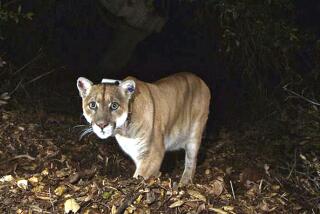Highway Deer Kills Are Problem for States : Wildlife: As many as 350,000 deer die each year on America’s roads. Last year, 131 people died in such collisions; damages and cleanup costs are in the millions.
- Share via
CHARLESTON, W.Va. — Thousands of times each day, a white-tailed deer comes nose to grille with a motor vehicle, often with disastrous results.
And not just to the deer, though as many as 350,000 deer die each year on America’s roads. Last year, 131 people died in collisions with animals, and damages and the costs of cleaning up total in the millions of dollars.
Wildlife and highway officials say there’s no simple way to keep the creatures and man from colliding on the nation’s roads.
A growing deer population--there are now 16 million to 18 million white-tailed deer in the United States and Canada--and “human sprawl” is forcing traffic engineers and wildlife officials to seek ways to keep the animals off the road.
“It’s a fairly severe problem, particularly if it’s your car that’s been hit,” said Richard McCabe of the Wildlife Management Institute in Washington.
“The problem is that with concentrated deer populations, particularly in states such as Pennsylvania and northern Wisconsin that are semi-mountainous, you have highways that intersect travel routes of deer,” he said.
In West Virginia, the death rate grew from 2,660 deer in 1979 to 6,326 in 1989. The typical animal that was struck caused about $1,300 in damage, said Roger Russell of the state Division of Highways.
Pennsylvania, which has a deer population of more than 1.5 million, spends about $8 million each year to collect dead deer off the roads, said state Game Commission spokesman Ted Godshall.
Game officers picked up more than 40,000 deer carcasses from the highways last year; they are given to needy families, fed to fish or buried.
“I know that it takes a minimum of two hours to pick up a deer, and they usually have to drive 50 miles or more,” Godshall said. “It can take two or three hours of an officer’s time. It’s a tremendous bill.”
The remedies for road kills are varied. Among them is more careful planning of where roads go; re-examination of grasses and shrubs planted along roads; dispensing with salt as a way of ridding roads of ice, because deer like salt; and more warning signs.
Colorado and Pennsylvania are considering rerouting deer over and under major thoroughfares, McCabe said. This seems “to have some benefits, but of course deer populations can change,” he said. “Underpasses and overpasses are fairly expensive propositions if you don’t know whether the deer are going to move.”
Fences, by all accounts the most effective remedy, also are expensive, costing as much as $200,000 a mile. A more recent solution, wildlife warning reflectors, costs $7,000 per mile.
“The reflectors light up and set up an unnatural moving light pattern, which scares the deer,” said John Strieter, president of Strieter Corp., which sells the reflectors. “We don’t know what’s going on in the deer’s head, but eyewitnesses say the deer react with them and change directions.”
In Minnesota, the reflectors are being used at 30 sites, with a dozen more to be added. Susan Mulvihill, accident surveillance safety engineer for the state Department of Transportation, said they seem to be working.
“When we figure out a benefit cost, we use 60% reduction as an average, so they’re pretty effective if you install them right,” Mulvihill said. “We’ve had pretty good luck with them here. It’s worked better than anything else we tried.”
But the high cost and mixed results at a 2-mile test-strip along Interstate 79 have made West Virginia officials skeptical.
“It is fairly expensive and it isn’t 100% effective in reducing deer kill. . . ,” Russell said. “The only thing that is 100% effective is an 8-foot tall fence.”
Whistles attached to vehicles to frighten deer by emitting high-pitched sounds also have shown limited effectiveness, McCabe said.
“I don’t hold much credence in it at all,” he said. “It may scare off deer that are standing in the roads, but it doesn’t do much for those out of the periphery of the sounds that are running along the highway. Those tend to be the deer that are hit anyway.”
“Everything has been tried, nothing works,” Godshall said. “Fencing is the best thing, but they’re prohibitively expensive.”
The problem, wildlife officials say, is not really with the deer at all. It’s people.
“People are inclined to spread out in attractive areas that are hilly and have forests--areas that are traditionally and ecologically principal and critical habitats of deer and certainly other wildlife,” McCabe said.
“There’s more traffic, more miles of travel being done each year, and more roadways to accommodate that traffic,” he said. “What it all comes down to is when a deer bangs into a car, people tend to get annoyed at the deer, but it’s the people who are more or less invading the deer’s habitat, and all of this is a consequence of human sprawl.”
More to Read
Sign up for Essential California
The most important California stories and recommendations in your inbox every morning.
You may occasionally receive promotional content from the Los Angeles Times.













